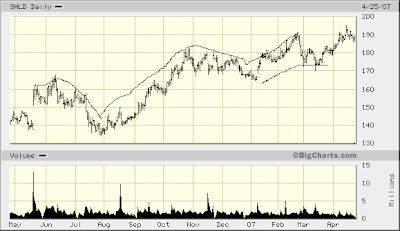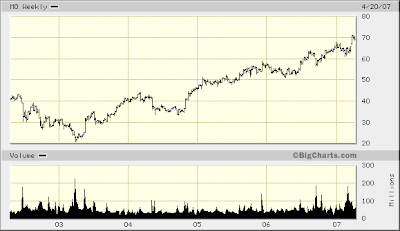First quarter sales declined 17 percent.
“As expected, our performance in the first quarter reflected weaker volume in our building materials businesses associated with the significant slowdown of new residential construction in the U.S.,” said Dave Brown, president and chief executive officer. “We are focused on delivering value to our customers through innovation, and our productivity initiatives to drive operational performance in a weaker market.
“Our Composite Solutions business continues to deliver solid results,” said Brown. “Strong demand for glass fiber materials in North America and Europe delivered improved margins that allowed us to offset cost inflation. Our Japanese acquisition, completed in the second quarter of 2006, also improved our top-line growth.”
When reviewing the operating performance of the company with its Board of Directors and employees, management makes adjustments to earnings before interest and taxes (“EBIT”) and diluted earnings per share. To calculate “adjusted EBIT” and “adjusted diluted earnings per share,” management excludes certain items from net earnings and earnings before interest and taxes, including those related to the company’s Chapter 11 proceedings, asbestos liabilities, and restructuring and other activities, so as to improve comparability over time (the “Comparability Items”). As described more fully in the attached financial schedules, such Comparability Items amounted to charges of $28 million in the first quarter of 2007 compared to a credit of $1 million during the same period of 2006.
Consolidated First-Quarter Results
— EBIT in the first quarter of 2007 was $33 million, compared with $115 million during the same period of 2006. Adjusted EBIT for the first quarter of 2007 was $61 million, compared with $114 million during the same period in 2006. The decline was primarily due to lower sales as the weakening new residential construction market impacted demand for building materials, and higher material and delivery costs.
— Diluted earnings per share for the first quarter of 2007 were $0.01. Adjusted diluted earnings per share for the first quarter of 2007 were $0.14.
Quarter Highlights:
- — Weakened demand in Insulating Systems and Roofing and Asphalt, combined with seasonal slowdowns in the building materials market, resulted in continued production curtailments at selected manufacturing facilities during the first quarter.
- — Demand for glass fiber reinforcement products was robust in the first quarter, leading to higher capacity utilization and improved productivity.
- — At the end of the first quarter of 2007, the company had $2.063 billion of short- and long-term debt, compared with $2.736 billion at the end of 2006. The company’s debt at the end of 2006 included a note payable to the 524(g) Trust of $1.390 billion, plus interest, which was paid in full on January 4, 2007, a portion of which was funded by borrowing $600 million under the company’s delayed draw senior-term loan facility during the first quarter of 2007.
- — Owens Corning announced a share buy-back program in the first quarter under which the company is authorized to repurchase up to 5 percent of Owens Corning’s outstanding common stock. The company did not repurchase any shares during the first quarter.
On February 20, 2007, Owens Corning and Saint-Gobain announced that they signed a joint-venture agreement to merge their respective reinforcements and composites businesses, thereby creating a global company in reinforcements and composite fabrics products with worldwide revenues of approximately $1.8 billion and 10,000 employees. The new company, to be named “OCV Reinforcements,” will serve customers with improved technology, an expanded product range and a strengthened presence in both developed and emerging markets. The transaction, which has been approved by the Boards of Directors of both parent companies, is subject to customary closing conditions and regulatory and antitrust approvals. Given the timing of regulatory and antitrust review, the joint venture is targeted to close during the second half of 2007.
Update: Strategic Business Review: Siding Solutions Business & Fabwel Unit
Consistent with Owens Corning’s ongoing review of its businesses, the company announced during the first quarter that it will explore strategic alternatives for its Siding Solutions business, which includes its vinyl siding manufacturing operations and Norandex/Reynolds distribution business, and the company’s Fabwel unit, the leading producer and fabricator of components and sidewalls for recreational vehicles and cargo trailers. The company expects a midyear completion of this review process.
2007 Outlook
Based on current estimates by the National Association of Home Builders (NAHB), the slow down in U.S. housing starts is expected to carry well into 2007, which will continue to impact the company’s Insulating Systems business. Demand for Owens Corning’s Roofing and Asphalt products is driven primarily by the repair of residential roofs, with lesser demand coming from housing starts. Owens Corning is assuming a more normal level of demand associated with storm activity in 2007.
Owens Corning expects that the Composite Solutions segment will benefit from strong global demand for glass fiber materials throughout 2007. In addition, the recent introduction of new products has the potential to positively impact this segment in 2007.
Upon emergence and the subsequent distribution of contingent stock and cash to the 524(g) Trust in January 2007, Owens Corning generated a significant U.S. Federal tax net operating loss of approximately $2.8 billion. Based on current estimates, the company believes its cash taxes will be about 10 to 15 percent of pre-tax income for the next five to seven years. Owens Corning anticipates that its effective tax rate will be approximately 36.5 percent for 2007.
Allowing for continued uncertainty and based upon the NAHB’s current 2007 estimate of 1.45 million housing starts, the company continues to project that 2007 adjusted EBIT should exceed $415 million, not including the impact of the proposed Owens Corning – Vetrotex joint venture or other strategic organizational changes. This forecast will be updated and communicated quarterly.
First-Quarter Business Segment Highlights
Insulating Systems
— EBIT for the first quarter was $53 million, compared with $122 millionduring the same period in 2006. Results were unfavorably impacted by a decline in sales volumes, changes in product mix, idle facility costs resulting from production curtailments, and increases in material and labor costs. In addition, results were negatively impacted by $11 million, primarily related to depreciation and amortization costs, resulting from the adoption of Fresh Start Accounting.
Composite Solutions
— EBIT for the first quarter of 2007 was $26 million, compared with $14 million during the same period in 2006. The improvement was primarily the result of stronger demand, manufacturing productivity, improved margins and lower marketing and administrative costs. Results for the first quarter of 2006 also included approximately $6 million in expense resulting from downtime to repair and expand the company’s Taloja, India manufacturing facility, and $8 million of gains on the sale of metal. Results were negatively impacted by $1 million resulting from the adoption of Fresh Start Accounting.
Roofing and Asphalt
— EBIT for the first quarter was a loss of $8 million, compared with record first quarter earnings of $29 million during the same period in 2006. The decrease was primarily driven by lower volume resulting from declines in new construction activity in North America, combined with lower storm-related demand and the impact of higher material costs. Results were negatively impacted by $1 million resulting from the adoption of Fresh Start Accounting.
Other Building Materials and Services
— EBIT for the first quarter of 2007 was a loss of $1 million, compared with a loss of $3 million during the same period in 2006. The improvement was primarily due to increased earnings in the company’s Cultured Stone® business. The adoption of Fresh Start Accounting had no significant impact on this segment during the first quarter of 2007.
Synopsis:
As expected, a lousy quarter. As value investors we buy businesses when they are hopefully at their worst. Owen’s clearly is at that level yet it is still making money. The real important takeaways is that full year guidance was unchanged. The St. Gobian merger will go through later this year. An active (or even moderate) hurricane season will really bolster the stock and any revival in housing will help. Essentially all business segments (except composites) are bottoming. as value investors this is the perfect spot to be in as we will ride the wave when they rebound laster this year. Like I have said many times before, ignore today’s price activity in the stock. If it gets hit hard enough, buy more, the downside from here is minimal. This investment in a two year one at a minimum, do not let one quarter or one half a year shake you out of what will end up being a very profitable investment down the road.
I will be on the call today at 11 and update with any important announcements.









